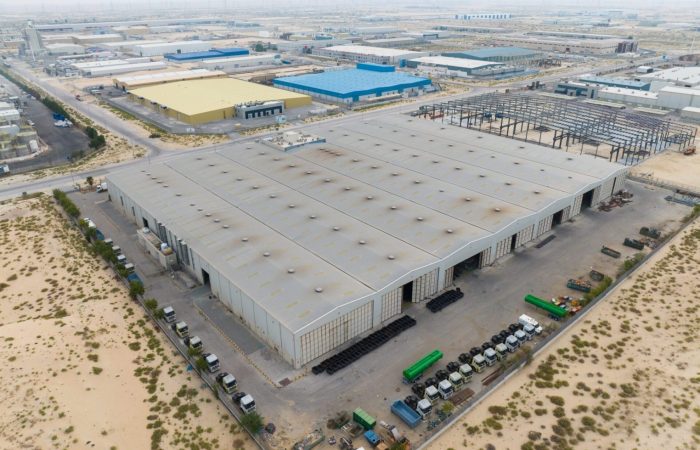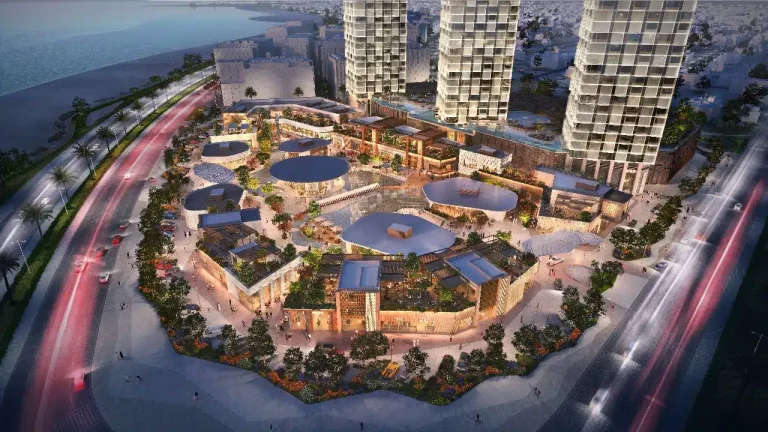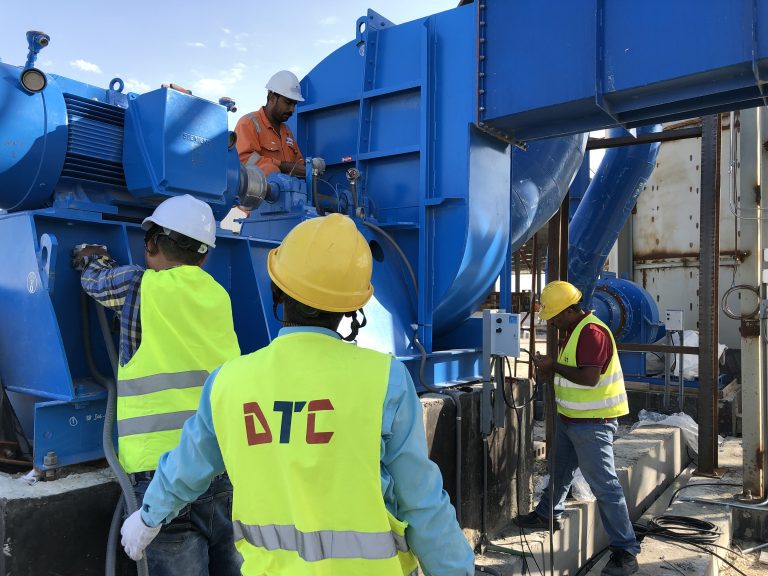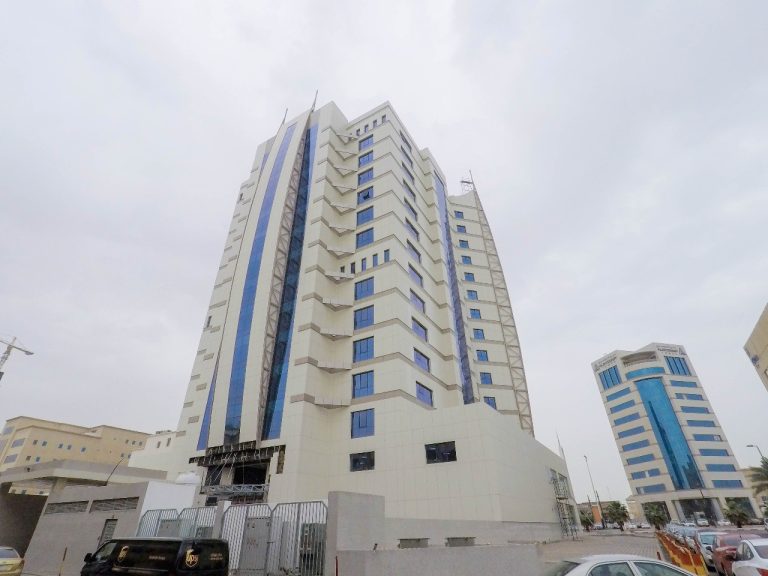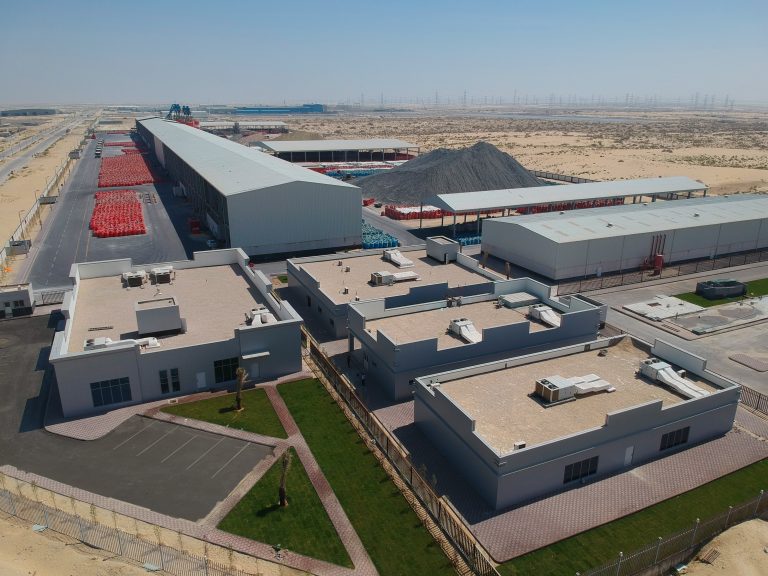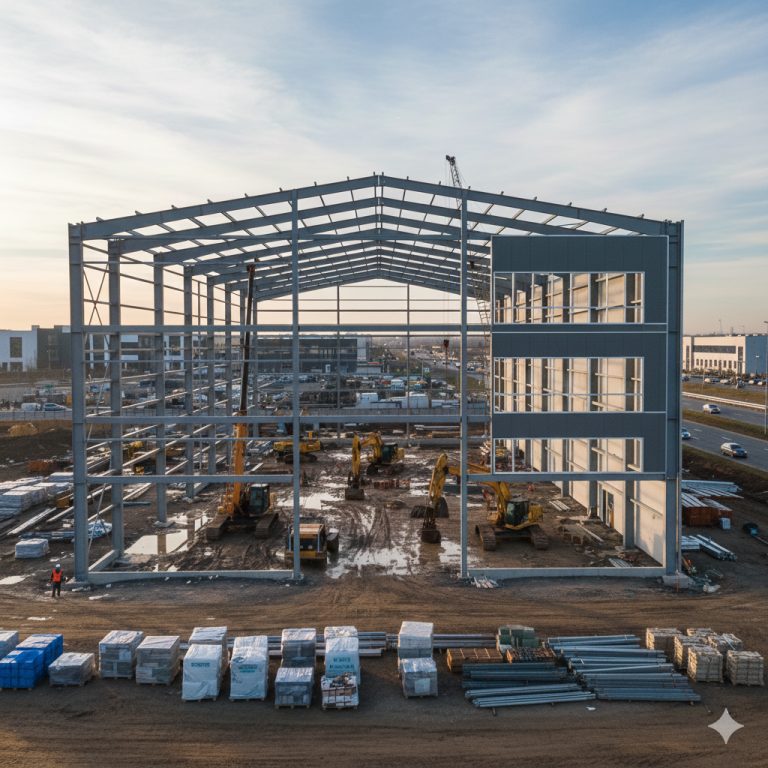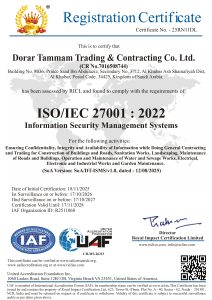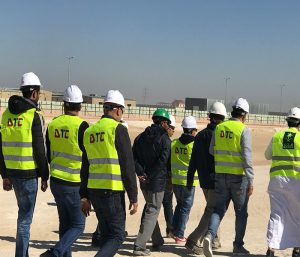warehouse and industrial building technology Saudi Arabia
1. Introduction: The Changing Landscape of Logistics & Industrial Construction in Saudi Arabia
Saudi Arabia is undergoing a profound transformation in its industrial and logistics sectors. With Vision 2030, the Kingdom has set ambitious goals to diversify away from just oil revenues, position itself as a global logistics hub, and develop advanced industrial zones. To support this, Saudi Arabia is rapidly expanding warehouse and industrial building capacity. In the first half of 2025 alone, more than 1.3 million m² of new industrial/warehouse space was added across the country. economymiddleeast.com
However, building more square meters is only part of the story. The real competitive edge lies in how warehouses and industrial facilities are designed, constructed, and operated. Traditional warehouses and factories are being supplanted by smart, automated, energy-efficient buildings that combine structural innovation with deep integration of digital and automation technologies.
For a general contracting firm like DTC General Contracting, leading this shift means mastering not just civil and structural works, but also systems integration, robotics, IoT, and digital design. This article explores the current and emerging technologies in warehouse & logistics buildings and industrial building construction, especially within Saudi Arabia’s context.
2. Why Innovation Matters in Warehouses & Logistics Buildings
Before diving into technologies, it helps to understand the key drivers pushing the shift. Without these drivers, innovations would be optional; but in Saudi Arabia’s logistics ambitions, they are becoming essential.
-
Operational Efficiency & Cost Reduction: Automated systems reduce manual labor, minimize errors, speed up throughput, and lower operating costs.
-
Competitive Advantage & Market Differentiation: Logistics firms and supply chain actors need faster, more reliable service to compete regionally.
-
Labor Constraints & Skills Gap: As labor markets evolve, it’s harder to rely purely on human workforce, especially for repetitive or heavy tasks.
-
Scalability & Flexibility: Automated systems can scale and adjust to peak seasons (like e-commerce spikes) more readily than human systems.
-
Risk & Resilience: Smart systems with predictive maintenance can reduce downtime, and real-time monitoring can help respond to disruptions.
-
Sustainability & Energy Efficiency: Green building considerations, power management, and reduced waste align with Saudi Arabia’s sustainability goals.
-
Government & Policy Push: Under the National Industrial Development & Logistics Program (NIDLP), Saudi Arabia sees logistics as a strategic sector, attracting investment, regulation, and incentives.
In short, warehouses and industrial buildings are no longer passive boxes — they are now active, integrated systems.
3. Key Technologies Transforming Warehouses in Saudi Arabia
Let’s look at the specific advanced technologies transforming logistics buildings, especially in the Saudi context.
3.1 Robotics & Artificial Intelligence (AI)
Robotics combined with AI is at the heart of the smart warehouse revolution. Robots can handle picking, packing, sorting, and transport tasks within a warehouse, reducing human error and boosting speed.
-
Autonomous Mobile Robots (AMRs) roam freely and can adapt routes.
-
Automated Guided Vehicles (AGVs) follow fixed paths or guided tracks.
-
Robotic arms / picking robots can handle individual item picking, especially in e-commerce.
-
AI enables real-time decision-making, dynamic routing, anomaly detection, and optimization of resource allocation.
In Saudi Arabia, several warehouses already pilot AI-driven robot systems to speed up sorting and reduce reliance on manual labor.
3.2 IoT & Sensors / Real-Time Monitoring
The Internet of Things (IoT) enables pervasive sensing and connectivity:
-
Temperature, humidity, vibration sensors (especially for cold chain or sensitive goods).
-
Asset tracking (RFID, Bluetooth, UWB) to monitor movement of pallets, packages, tools.
-
Condition monitoring and predictive alerts (e.g., motor bearings, conveyor belts).
-
Real-time dashboards and alerts for warehouse managers.
Saudi Arabia is also developing 59 logistics zones designed to incorporate IoT from the ground up.
3.3 Automated Storage & Retrieval Systems (AS/RS)
AS/RS systems automate the storage and retrieval of goods in high-density shelving:
-
Crane-based systems, shuttles, vertical lifts.
-
High throughput, compact footprint, reduced picking times.
-
Highly effective in cold storage, spare parts, and high-value goods.
AS/RS are becoming a standard expectation in modern Saudi warehouses.
3.4 Conveyor & Sortation Systems
Complex conveyor networks and sortation systems move goods between zones — receiving, storage, picking, packing, shipping.
-
Multi-level conveyors, cross-belt sorters, sliding shoe sorters.
-
Integration with robotics to feed material to picking robots.
-
Dynamic routing and switching based on order flows.
3.5 Digital Twins & Simulation
Digital twins are virtual replicas of warehouses, modeling every aspect — layout, flows, systems — enabling simulation and optimization.
-
Simulate layout changes, peak load, failure scenarios.
-
Test automation strategies before physical deployment.
-
Ongoing monitoring with synchronization between digital twin and physical operations.
3.6 Warehouse Management & Control Systems (WMS / WCS)
The software backbone — WMS (Warehouse Management System) and WCS (Warehouse Control System) — orchestrates operations.
-
Inventory tracking, order assignment, task scheduling.
-
Integration with ERP, supply chain systems.
-
Real-time control, analytics, reporting, dashboards.
WMS ensures smooth coordination between structural layout, automation systems, and operations.
4. Examples & Adoption in Saudi Arabia
Here are some local examples and trends that illustrate how these technologies are being adopted in Saudi Arabia:
-
Swisslog has committed to driving logistics innovation in KSA, delivering solutions with AMRs, AI, and energy-efficient systems aligned with Saudi Vision 2030.
-
Al Barrak Group is actively deploying warehouse automation, leveraging robotics, conveyors, and smart warehouse systems across its logistics portfolio.
-
The launch of a fully automated warehouse by Home Centre featured driverless vehicles — an early Saudi experiment in autonomous internal transport.
-
The expansion of 59 logistics zones is a national move towards integrating smart warehousing across the country.
-
The AI-powered warehouse robotics market in Saudi Arabia is estimated at ~$1.2 billion, driven by e-commerce and automation demand.
These examples indicate that the Kingdom is not just planning — it’s actively building and operating smart warehouses and logistics assets.
5. Challenges & Barriers in Implementation
While the benefits are real, adoption is not without challenges, especially in a region transitioning rapidly:
-
High initial capital investment for robotics, automation, and sensors.
-
Integration complexity: aligning new systems with legacy infrastructure, ERP, electrical and mechanical systems.
-
Skills & workforce readiness: hiring or training engineers, technicians, data scientists.
-
Change management: operational culture shifts, employee acceptance, process redesign.
-
Reliability & downtime risk: automated systems must be resilient and maintain high uptime.
-
Scalability & flexibility: ensuring modularity so systems can expand or reconfigure.
-
Regulatory & safety compliance: meeting Saudi building codes, worker safety, data security.
A contractor or developer not prepared for these can face cost overruns or underutilized systems.
6. Building Technology Trends in Industrial / Factory Buildings
Beyond warehouses, industrial buildings (manufacturing, processing, assembly) also benefit from innovations in construction methods and systems.
6.1 Prefabricated & Modular Construction
-
Off-site fabrication of structural elements, panels, modules.
-
Faster assembly on-site, reduced wastage, safer construction sites.
-
Modules can integrate embedded conduits, piping, insulation.
6.2 Precast Concrete & Composite Systems
-
Precast structural frames, slabs, facade walls accelerate construction.
-
Composite steel-concrete elements reduce weight and provide design flexibility.
-
Use of Rapidwall® technology in Saudi, offering integrated wall systems for industrial facilities.
6.3 Advanced Structural Systems & Long Spans
-
Use of high-strength steel, hybrid frames, trusses to allow wide clear spans for large industrial halls.
-
Cable-stayed roof systems, space frame structures.
6.4 Building Envelope & Cladding Technology
-
High-performance insulated panels, sandwich panels, composite facades.
-
Fire-rated cladding, reflective surfaces, ventilated facades to reduce heat load.
-
Smart facades: dynamic shading, sensors for thermal control.
6.5 Foundation Innovations & Ground Improvement
-
Deep foundations, micropiles, floating slabs, ground stabilization for large loads.
-
Geosynthetics, soil mixing methods, controlled compaction.
7. Smart & Green Building Systems for Industrial Facilities
Industrial buildings are energy-intensive. Smart systems can reduce consumption, improve comfort, and lower lifecycle costs.
-
HVAC / MEP integration: variable speed drives, smart ducting, demand-based ventilation.
-
Building Automation Systems (BAS) / BMS: centralized control of lighting, HVAC, fire, security systems.
-
Onsite renewables & solar PV: solar panels on roof, solar carports.
-
Energy storage / battery systems to smooth demand peaks.
-
Waste heat recovery, cogeneration, efficient boilers.
-
Smart lighting (LED + sensors), daylight harvesting.
-
Green roofs, insulation, thermal breaks to reduce heat gain.
-
Water recycling and rainwater harvesting, greywater systems.
Smart industrial buildings monitor energy, adjust in real time, and reduce carbon footprint.
8. Role of BIM, Digital Twins & Simulation in Industrial Buildings
In modern industrial construction, the digital layer is just as important as the physical.
-
BIM (Building Information Modeling): multi-disciplinary digital models combining architecture, structure, MEP, automation systems. Helps clash detection, coordination, and reduces rework.
-
Digital twins: evolving models of the finished building, syncing data to allow predictive maintenance, performance monitoring.
-
Simulation & optimization tools: simulate airflow, process flows, structural loads, energy use.
-
Lifecycle management: as-built BIM becomes a central repository for maintenance, retrofits, expansions.
For industrial clients, this means improved ROI, fewer downtime disruptions, and smarter maintenance.
9. Advanced Materials & Envelope Technologies
Materials can dictate performance, durability, and energy efficiency:
-
High-performance insulation (aerogel-infused, vacuum insulated panels).
-
Composite cladding panels combining strength, thermal resistance, ease of installation.
-
Fire-resistant materials and intumescent coatings.
-
Self-healing concrete, fiber-reinforced concrete for durability.
-
Photovoltaic-integrated panels (building-integrated PV).
-
Phase change materials (PCMs) in walls/ceilings for thermal mass control.
-
Surface coatings (cool roofs, reflective coatings) to reduce solar heat gain.
These materials help the building envelope support automation systems by stabilizing interior environments and lowering loads.
10. Case Study: DTC General Contracting’s Role & Vision
For DTC General Contracting, engaging in these technologies is both a challenge and an opportunity. Here’s how DTC can position itself as a leader:
-
Integrated contracting & systems integration: DTC should build cross-disciplinary teams combining civil, structural, mechanical, automation, and IT expertise.
-
Strategic partnerships: Form alliances with robotics vendors (AMR/AGV firms), software providers (WMS/BMS), material suppliers, and consultants.
-
Pilot projects & showcase warehouses: Construct demonstration smart warehouses or industrial facilities to showcase capability.
-
Design-build approach: Offer turnkey solutions rather than just handing over structure — integrate automation, sensors, control systems.
-
Modular & scalable design: Ensure buildings are adaptable to future tech upgrades.
-
Emphasis on sustainability: Market green, energy-efficient industrial buildings as a differentiator.
-
Training & local talent development: Invest in upskilling in robotics, IoT, software, digital twins — contribute to Saudi’s localization agenda.
-
Standards & compliance: Ensure designs meet Saudi building codes, fire safety, data security, and fit NIDLP / Vision 2030 objectives.
By doing this, DTC can become the go-to contractor for next-gen warehouse & industrial buildings in Saudi Arabia.
11. Integration of Warehouse Tech with Building Systems
One of the biggest differentiators is how well the automation and building systems are integrated from the start.
-
Automation loads (power, vibrations, dynamic forces) need structural and electrical planning.
-
HVAC and cooling needs must anticipate robotics heat generation, server rooms, control cabinets.
-
Cable routing, conduits, access for maintenance must align with robotic paths and service corridors.
-
Safety systems, fire suppression, emergency egress must be co-designed.
-
Control systems (BMS, WMS, SCADA) should interoperate.
-
Expansion zones and flexibility should be embedded in design.
Designing in silos results in conflicts, rework, or compromised performance.
12. Future Trends & Emerging Tech
Looking ahead, these trends will further change the game:
-
Drone / UAV logistics: internal and external drone delivery in warehouse yards.
-
Autonomous buildings: buildings that self-optimize HVAC, lighting, operations.
-
Predictive maintenance & AI: systems that anticipate failures in conveyors, robots, MEP systems.
-
Edge computing & 5G networks: enable low-latency control and real-time analytics in large warehouses.
-
3D printing of structural or architectural components on-site.
-
Swarm robotics & multi-agent systems: fleets of small robots collaborating dynamically.
-
Augmented reality (AR) / VR in maintenance, training, operations.
-
Blockchain / distributed ledgers for supply chain transparency and security.
Saudi Arabia’s projects like Neom and Oxagon are testbeds for many of these futuristic building ideas.
13. Strategies for Adoption & Scale-up
To successfully adopt these technologies, stakeholders can follow these strategies:
-
Start with pilot projects: implement new tech in one zone or facility before full-scale rollout.
-
Modular / phased approach: design buildings that can evolve gradually.
-
Cross-disciplinary teams: ensure architects, structural, MEP, automation, IT collaborate from day one.
-
Partner ecosystems: engage robotics firms, software vendors, research institutes.
-
Local talent investment: train engineers, technicians, software experts.
-
Performance-based ROI models: quantify benefits in OPEX savings, throughput gains to justify capex.
-
Maintenance & spare parts planning: ensure long-term support, spare parts inventories, remote diagnostics.
-
Standards & compliance roadmap: ensure regulatory, safety and cybersecurity requirements are built in.
14. Impacts on Supply Chains & Industrial Growth
Smart warehouse and industrial buildings aren’t just technical novelties — they reshape how supply chains and industrial ecosystems operate.
-
Faster throughput and lower lead times improve customer satisfaction.
-
Lower logistics cost helps reduce product costs and increase margins.
-
Improved reliability and reduced errors create stronger brand trust.
-
Attract foreign investment: advanced infrastructure becomes a magnet for global firms.
-
Regional logistics hub: Saudi Arabia’s positioning between Asia, Europe, Africa is strengthened.
-
Industrial clustering & synergies: smart factories and logistics nodes can cluster to build ecosystems.
-
Export competitiveness: efficient logistics lowers barriers to global trade.
15. Risks & Mitigation
Even as the benefits are compelling, risks exist:
-
Cybersecurity vulnerabilities: connected systems can be attacked.
-
System failure / downtime: machinery breakdowns can halt operations.
-
Vendor lock-in: overreliance on a single automaton provider.
-
Obsolescence risk: selecting technology that may become outdated.
-
Cost overruns / budget risk: underestimating integration complexities.
-
Regulatory changes: building codes, data laws may evolve.
-
Data privacy / IP risk: protecting operational data.
Mitigation strategies include redundancy, backup systems, open architecture / modular systems, clear maintenance contracts, cybersecurity frameworks, and pilot testing.
16. Recommendations for Stakeholders
-
For Developers / Owners: Insist on smart infrastructure and integrated design from the start.
-
For Contractors (like DTC General Contracting): Build digital & systems integration capacity, develop partnerships, start with demonstration projects.
-
For Logistics / Warehouse Operators: Collaborate early in design, define throughput needs, demand scalability and modularity.
-
For Government / Regulators: Offer incentives, standards, R&D support, adopting smart building codes.
-
For Technology Providers: Localize offerings, adapt to Saudi climate, provide servicing, training, warranty support.
-
For Investors / Financiers: Use performance-based financing, emphasize ROI in OPEX savings, and risk mitigation.
17. FAQs
Q1: What is the adoption status of smart warehouses in Saudi Arabia?
A: Adoption is accelerating. The Kingdom is investing heavily in logistics, having launched 59 logistics zones with smart infrastructure integration. Automated and robotic warehouses are increasingly common among major logistics players. saudilogisticsconsulting.com
Q2: Is automation cost-effective for new warehouses in Saudi Arabia?
A: Yes — although the capital cost is high, the OPEX savings, throughput gains, lower error rates, and scalability often justify it over 5–10 years, especially in high-volume operations.
Q3: Can existing warehouses be retrofitted with automation technology?
A: Yes, many systems are modular. However, retrofitting can pose integration challenges (power, structural loads, routing) and often requires detailed planning.
Q4: What industrial building technologies are best suited to Saudi’s climate?
A: Technologies like high-performance insulation, reflective claddings, ventilated facades, efficient HVAC systems, integration of solar PV, and smart shading systems are especially apt for hot climates.
Q5: How does DTC General Contracting benefit from embracing these technologies?
A: DTC can differentiate itself as a leader in next-gen industrial and logistics buildings, attract clients seeking turnkey smart facilities, command premium pricing, and contribute to national development goals.
Q6: What are the main barriers to adoption?
A: High upfront cost, integration complexity, skills gap, change management, and system downtime risk. Careful planning, pilot projects, and partnerships can mitigate many of these.
Conclusion
The future of warehouse and industrial building technology in Saudi Arabia lies at the intersection of construction innovation, automation, digital systems, and sustainability. As the Kingdom races to become a logistics and industrial powerhouse under Vision 2030, buildings cannot remain static shells — they must become smart, adaptive, efficient systems.
For a general contracting firm like DTC General Contracting, this transformation presents a golden opportunity: to lead, innovate, and deliver added value beyond traditional structure building. By developing competencies in robotics, IoT, BIM, modular construction, and integrated systems, DTC can position itself as the preferred partner for the next generation of warehouses and factories across Saudi Arabia.
Would you like me to refine this further — for example, localize to Dammam / Eastern Province, or add illustrative visuals, or a slide-deck outline?

